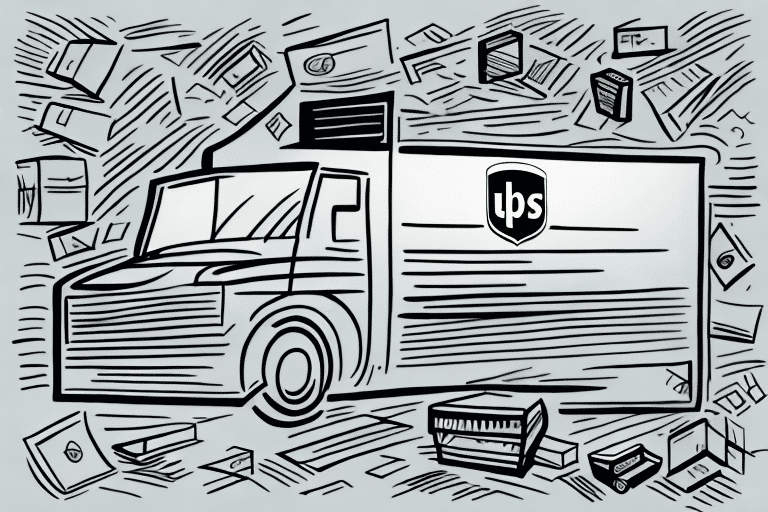Shipping Large Packages with UPS: A Comprehensive Guide for Oversized Shipments
Shipping a large package that exceeds traditional size and weight limitations can be challenging. While many carriers impose restrictions on the dimensions and weight of packages, UPS offers solutions to help you navigate these hurdles. In this guide, we'll delve into everything you need to know about shipping large packages with UPS, including current size and weight restrictions, types of eligible packages, preparation tips, cost considerations, and more.
Understanding UPS Size and Weight Limits
Before shipping, it's crucial to understand UPS's current size and weight limitations to ensure your package complies with their guidelines and avoid unexpected fees.
Current Size Limits
- Maximum Weight: 150 pounds per package for most UPS services.
- Maximum Dimensions: The combined length and girth (length + 2 × (width + height)) cannot exceed 165 inches.
These limits apply to most UPS services, including UPS Ground. For packages exceeding these dimensions or weight, UPS Freight services may be necessary.
Comparing Length and Girth
Length: The longest side of the package.
Girth: Calculated by adding the width and height of the package and multiplying by two. For example, a package with a length of 60 inches, a width of 30 inches, and a height of 40 inches would have a girth of (30 + 40) × 2 = 140 inches, and a total size of 60 + 140 = 200 inches, which exceeds UPS's maximum size limit.
Accurately measuring your package ensures compliance with UPS regulations and helps in calculating the correct shipping charges.
For the most up-to-date information, refer to the UPS Packaging and Supplies page.
Types of Large Packages Eligible for UPS Shipping
UPS accommodates a wide range of large and bulky items, provided they adhere to their size and weight restrictions. Common types of large packages include:
- Furniture: Items like sofas, tables, and chairs.
- Electronics: Large appliances, televisions, and computer equipment.
- Musical Instruments: Guitars, keyboards, and drum sets.
- Exercise Equipment: Treadmills, weights, and exercise bikes.
- Artwork: Paintings, sculptures, and framed pieces.
- Documents and Blueprints: Oversized paperwork requiring specialized packaging.
Each category may require specific packaging techniques to ensure safe transit. For instance, artwork often necessitates custom crating and temperature control to prevent damage.
Preparing Your Large Package for Shipping
Proper preparation is essential to ensure your large package arrives safely and complies with UPS guidelines. Here are some essential tips:
Protective Wrapping
Securely wrap your item using protective materials such as bubble wrap, foam padding, or packing paper. This cushioning helps prevent damage during transit.
Choosing the Right Packaging
- Sturdy Boxes: Use double-walled or reinforced boxes for heavy or fragile items.
- Specialty Packaging: For irregularly shaped or valuable items, consider custom packaging solutions.
UPS offers a range of packaging supplies to assist with your shipping needs.
Labeling Your Package
Ensure your package is labeled accurately with both the sender's and recipient's addresses. Include any necessary shipping labels or documentation, and consider using fragile or handling instructions stickers if applicable.
Weighing and Measuring
Accurately weigh your package using a digital scale and measure its dimensions to determine the shipping cost. Accurate measurements help avoid additional fees and ensure proper handling.
Insurance and Declared Value
Consider purchasing insurance or declaring a higher value for valuable items. This provides financial protection in case of loss or damage during transit.
Choosing the Right Packaging Materials
The quality of your packaging materials significantly impacts the safety of your shipment. Here’s how to choose the right materials:
Sturdy Boxes
Opt for high-quality, durable boxes that can withstand the weight and abrasion during shipping. Double-walled boxes are recommended for heavier items.
Protective Fillers
- Bubble Wrap: Ideal for wrapping fragile items.
- Foam Padding: Provides cushioning for delicate equipment.
- Packing Peanuts: Fill empty spaces to prevent movement within the box.
Reinforcement Materials
Use heavy-duty packing tape to reinforce all seams and edges of the box. Reinforcing corners with additional tape or corner protectors adds extra strength.
For oversized items, consider using pallets and stretch wrap to secure the package for freight shipping.
Measuring Your Large Package for Accurate Shipping Rates
Accurate measurement of your package is vital for determining the correct shipping rate and ensuring compliance with UPS policies.
Step-by-Step Measurement Guide
- Measure the Length: The longest side of the package.
- Measure the Width and Height: These are the two sides perpendicular to the length.
- Calculate the Girth: Add the width and height, then multiply by two.
- Total Size: Add the length to the girth.
For example, a package with a length of 60 inches, a width of 30 inches, and a height of 40 inches would have a girth of (30 + 40) × 2 = 140 inches, and a total size of 60 + 140 = 200 inches, which exceeds UPS’s maximum limit of 165 inches.
Using UPS Tools
Utilize the UPS Shipping Calculator to input your package dimensions and weight. This tool helps estimate shipping costs and determine the best service option for your needs.
Comparing UPS Shipping Options for Large Packages
UPS offers various shipping services tailored to different needs. Understanding these options helps you choose the most suitable method for your large package.
UPS Ground
Ideal for non-urgent shipments, UPS Ground offers cost-effective shipping with delivery typically within 1-5 business days, depending on the distance.
UPS Air Services
- UPS Next Day Air: Delivery by the next business day.
- UPS 2nd Day Air: Delivery within two business days.
- UPS 3 Day Select: Delivery within three business days.
Air services are more expensive but provide faster delivery times.
UPS Freight
For packages exceeding standard size and weight limits, UPS Freight offers less-than-truckload (LTL) and full-truckload (FTL) shipping options. This service is suitable for very large or heavy items that require special handling.
International Shipping
If you're shipping large packages internationally, UPS provides a range of global shipping options, including customs clearance assistance and international tracking.
Use the UPS Shipping Services page to explore all available options and choose the best fit for your shipment.
Understanding the Cost of Shipping Large Packages with UPS
The cost of shipping large packages with UPS varies based on several factors. Understanding these can help you estimate and potentially reduce your shipping expenses.
Factors Influencing Shipping Costs
- Package Weight: Heavier packages incur higher shipping fees.
- Package Dimensions: Larger packages cost more due to increased space usage.
- Shipping Distance: Longer distances typically result in higher costs.
- Delivery Speed: Faster delivery options (e.g., next-day air) are more expensive.
- Additional Services: Insurance, signature confirmation, and special handling add to the cost.
Cost-Saving Tips
- Compare Services: Use UPS's shipping calculator to compare different services and choose the most cost-effective option.
- Optimize Packaging: Use appropriately sized packaging to avoid paying for unnecessary space.
- Schedule Pickups: Scheduling your own pickup can sometimes reduce costs compared to dropping off at a UPS location.
- Take Advantage of Discounts: Businesses often qualify for discounted rates. Enroll in UPS's business solutions for potential savings.
Scheduling a Pickup for Your Large Package with UPS
Convenience is key when shipping large packages. UPS offers several options for scheduling pickups to streamline the shipping process.
Scheduling Online
Visit the UPS Pickup page to schedule a pickup. You'll need to provide details such as package dimensions, weight, pickup location, and desired pickup time.
Using the UPS Mobile App
The UPS mobile app allows you to schedule pickups directly from your smartphone. Simply enter the required information, choose a pickup time, and confirm your request.
Alternative Drop-off Options
If scheduling a pickup isn't convenient, you can drop off your large package at a UPS Store or authorized drop-off location. Use the UPS Dropoff Locator to find the nearest location.
Tracking Your UPS Shipment
Monitoring your package's journey ensures peace of mind and allows you to address any issues promptly.
Tracking Tools
- UPS Tracking Number: Every shipment comes with a unique tracking number. Enter this number on the UPS Tracking page to view real-time updates.
- UPS My Choice: A free service that provides advanced tracking notifications, delivery alerts, and the ability to manage delivery preferences.
Notification Options
You can opt to receive tracking updates via email, SMS, or through the UPS mobile app, ensuring you're always informed about your package's status.
Common Pitfalls to Avoid When Shipping Large Packages with UPS
Avoiding common mistakes can save you time, money, and ensure your package arrives safely.
Inaccurate Measurements
Incorrectly measuring your package can lead to unexpected fees or delays. Always double-check your measurements and weight before shipping.
Poor Packaging
Using inadequate packaging materials can result in damaged items. Invest in quality packaging and protective materials to safeguard your shipment.
Ignoring UPS Guidelines
Failure to adhere to UPS's packaging and labeling guidelines can cause shipping delays or refusals. Review and follow all UPS instructions carefully.
Not Purchasing Insurance
Shipping valuable items without insurance leaves you vulnerable to loss or damage. Consider purchasing additional coverage for peace of mind.
Choosing the Wrong Shipping Option
Selecting an inappropriate shipping service can lead to longer delivery times or higher costs. Assess your needs carefully before choosing a service.
Dealing with Damaged or Lost Shipments: Your Rights and Next Steps
Despite careful preparation, sometimes packages may arrive damaged or get lost. Understanding your rights and the steps to take can help you resolve these issues effectively.
UPS Claims Process
- Report Damage or Loss: Notify UPS as soon as you become aware of the issue by filing a claim through the UPS Claims Center.
- Provide Documentation: Submit evidence such as photos of the damage, proof of value, and shipping receipts.
- Claim Resolution: UPS will investigate and, if the claim is approved, provide compensation based on the declared value.
Understanding Declared Value Coverage
Declared value is the maximum amount UPS will reimburse for lost or damaged items. It is not the same as insurance and must be declared at the time of shipping for valuable items.
For more information, visit UPS's Claims Information page.
Tips for Reducing Shipping Costs with UPS
Managing shipping expenses is essential, especially when dealing with large packages. Here are some strategies to help you minimize costs:
Optimize Packaging
Use appropriately sized packaging to avoid paying for unnecessary space. Efficient packaging not only reduces costs but also minimizes the risk of damage.
Choose Economical Shipping Options
If delivery speed is flexible, opt for ground or economy shipping services, which are typically more affordable than expedited options.
Leverage UPS Discounts
- Volume Discounts: Businesses that ship frequently can benefit from discounted rates based on shipping volume.
- Negotiated Rates: Contact UPS sales representatives to negotiate rates that align with your shipping needs.
Consolidate Shipments
Combine multiple items into a single shipment when possible. Consolidation can reduce the number of packages and, consequently, shipping costs.
Use UPS Packaging Supplies
Purchasing shipping supplies directly from UPS can ensure you use materials that meet their guidelines, potentially reducing the need for additional protective measures.
Alternative Options for Shipping Extra-Large or Heavy Items
If your package exceeds UPS's size and weight limits, you may need to explore alternative shipping methods to ensure safe and efficient delivery.
Freight Shipping Companies
- FedEx Freight: Offers LTL and FTL shipping options with nationwide coverage.
- Old Dominion Freight Line: Specializes in LTL regional and nationwide freight services.
- YRC Freight: Provides comprehensive freight shipping solutions for large and heavy shipments.
Freight shipping typically involves higher costs but accommodates larger, heavier items that standard carriers cannot handle.
Specialized Carriers
For unique or highly sensitive shipments, consider using specialized carriers that offer tailored services such as climate-controlled transportation or white-glove handling.
Local Moving Companies
For regional shipments, local moving companies may offer competitive rates and personalized services for transporting large items.
Peer-to-Peer Shipping Platforms
Platforms like uShip connect you with individual carriers who can transport oversized items, often at lower costs than traditional freight services.
Conclusion
Shipping large packages with UPS is entirely feasible with the right preparation and knowledge of their guidelines. By understanding UPS's size and weight limits, selecting the appropriate shipping service, utilizing quality packaging materials, and following best practices, you can ensure your oversized shipments arrive safely and cost-effectively. Additionally, exploring alternative shipping options and implementing cost-saving strategies can further enhance your shipping experience. Always stay informed by visiting UPS's official resources and consulting with their customer service for the latest information and assistance.






















